INSIDE ISSUE 19.35 | Aug. 28, 2020
 BIG STORY: Get tested regardless of symptoms, state health officials say
BIG STORY: Get tested regardless of symptoms, state health officials say
NEWS BRIEFS: Goldfinch urges flooding fixes now
COMMENTARY, Brack: Sanford is on target about debt, deficit
SPOTLIGHT: The S.C. Education Association
FEEDBACK: Get serious about pandemic responses
MYSTERY PHOTO: Mystery painting
HISTORY: Ever wonder where the Atlantic Ocean started?
Get tested regardless of symptoms, state health officials say
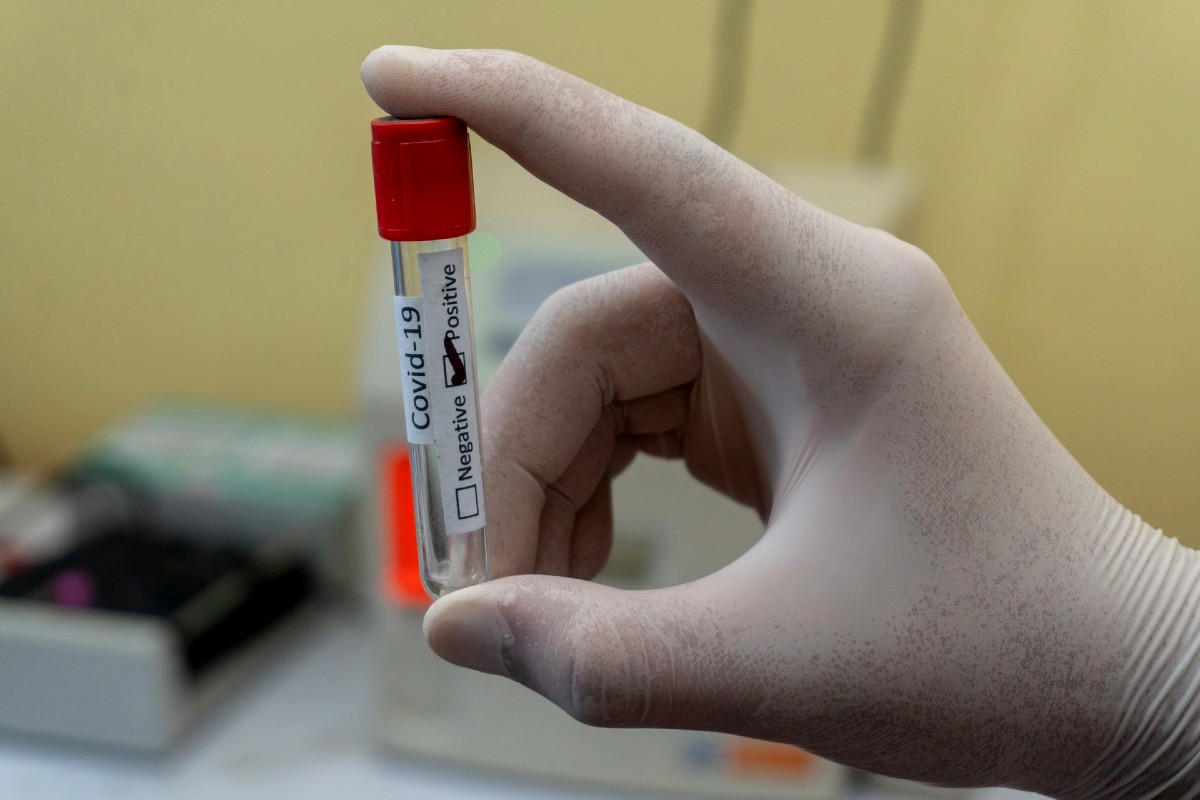
By Lindsay Street, Statehouse correspondent | State officials say coronavirus testing has declined in the last month while, at the same time, new cases have fallen under 1,000 per day.
But that doesn’t necessarily mean the state is recovering quickly from COVID-19, particularly since hospitalizations due to the virus are on the rise since Aug. 24.
One state official said the decline in new cases might be due to fewer tests being done.
“It’s possible that less cases have been identified due a recent decrease in overall testing,” according to statements by Dr. Brannon Traxler, a S.C. Department of Health and Environmental Control (DHEC) physician.
In comments this week that appear to buck federal advisories on testing, the state appears poised to expand testing to whole populations, not just those who have had contact with an infected person.
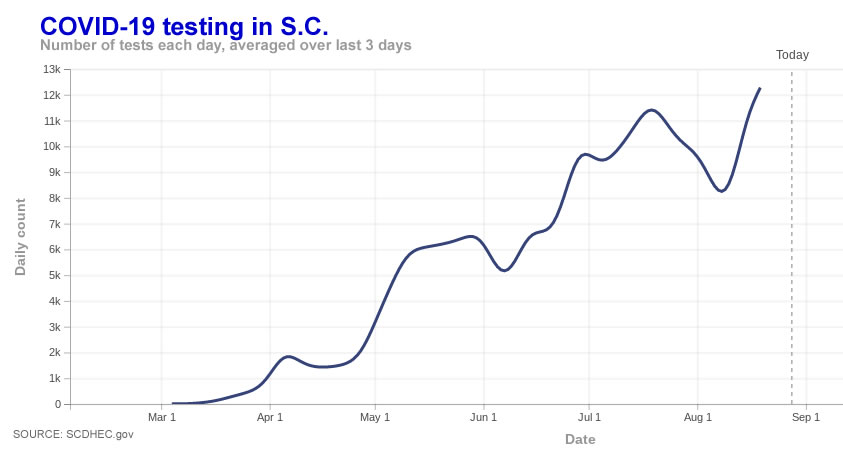 “We need to have more people getting tested regularly in order to stop this disease,” Traxler said, describing testing as “absolutely essential.”
“We need to have more people getting tested regularly in order to stop this disease,” Traxler said, describing testing as “absolutely essential.”
“It helps us identify people who are infected with the virus,” she said. “And testing is important for identifying individuals who have the virus but are asymptomatic and are spreading the virus unknowingly.”
In statements this week, the Centers for Disease Control and Prevention Director Dr. Robert Redfield said only people confirmed to have been exposed to the coronavirus should consider testing. Earlier this week, he had released a statement that only those exhibiting symptoms after an exposure needed a test.
It is unclear when Traxler made her statements, however. On Tuesday, Statehouse Report reached out to DHEC’s media relations staff asking to learn more about testing in South Carolina. DHEC’s Laura Renwick sent the comments from Traxler about 30 minutes later, characterizing them as “recent statements.” On Friday, prior to deadline, Statehouse Report tried unsuccessfully to clarify the timing of the statements since similar comments were made to other outlets and attributed to Traxler last week and the week before.
The question of who should get tested comes amid a Senate panel advising DHEC to expand daily testing to 10 percent of the state’s population (500,000 per month day) while the state has only tested 0.1 percent of the population over a 14-day average. Some experts say that’s not enough to show a true decline in cases or to curb the virus’ deadly spread.
The decrease in testing
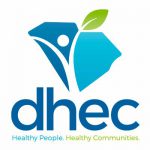 In the last 14 days, DHEC has reported an overall decline in positive cases, from more than 1,000 cases reported on Aug. 14 to 424 cases reported on Aug. 27. In that time period, the average number of tests per day has been 5,022, with an average percent positive of 14.7 percent for 723 daily cases, according to a report analysis by Statehouse Report.
In the last 14 days, DHEC has reported an overall decline in positive cases, from more than 1,000 cases reported on Aug. 14 to 424 cases reported on Aug. 27. In that time period, the average number of tests per day has been 5,022, with an average percent positive of 14.7 percent for 723 daily cases, according to a report analysis by Statehouse Report.
Testing has peaked and valleyed over the time frame. On Aug. 14, DHEC reported 6,767 tests. By Aug. 18, that daily number dropped to 3,715. Daily testing rose to a 14-day high of 7,438 on Aug. 21. But the number declined, again, to 5,235 tests Thursday.
Clemson University public health expert Lior Rennert called the question of decrease in cases “complicated.”
“This completely depends on why there is less testing,” he said.
Renwick in DHEC’s media relations told Statehouse Report this week some private labs have experienced longer wait times for results, “which can be a deterrent for individuals getting tested.”
“While DHEC doesn’t have authority over private labs — they are regulated at the federal level — DHEC is working with private labs to help with supply shortages where possible,” she wrote.
Renwick said DHEC’s Public Health Laboratory is “well-stocked” and has maintained a 24- to 48-hour turnaround on test results. The current daily capacity is 2,000 tests per day, but the agency has worked with private partners to bring that capacity up to 8,800 per day, she said. The agency only accounts for one-in-five tests in the state, according to DHEC data.
More testing ahead
Starting in September, DHEC will hold at least one testing event per week in each county, Renwick said. Two or three per week will be held in large counties. Those tests will be free and available to anyone regardless of symptoms. Results will be available within 48 to 72 hours, Renwick said.
DHEC is also working with the University of South Carolina, the Medical University of South Carolina and Clemson University on quicker, less invasive saliva testing, Renwick said.
To ramp up testing to adequate levels, the agency will need to employ saliva testing, Beaufort Republican Sen. Tom Davis said.
Davis told Statehouse Report he has recently emailed DHEC to again reiterate what the Senate wants from the agency in getting to 10 percent population testing daily.
“That’s something that should be happening now. We need this now, and you (DHEC) tell us, the General Assembly, what you need to get to that goal,” Davis said, adding that testing only 2 or 5 percent of the population won’t lead to mitigation of the virus.
“If we want to see cases decline, if we want to slow community spread, we ramp up testing. Testing whole populations on a mass-scale,” he said. “We know that’s the way to slow community spread.”
Davis said testing can help get people to self-isolate and help identify more infected people for contact tracers.
Why more testing matters
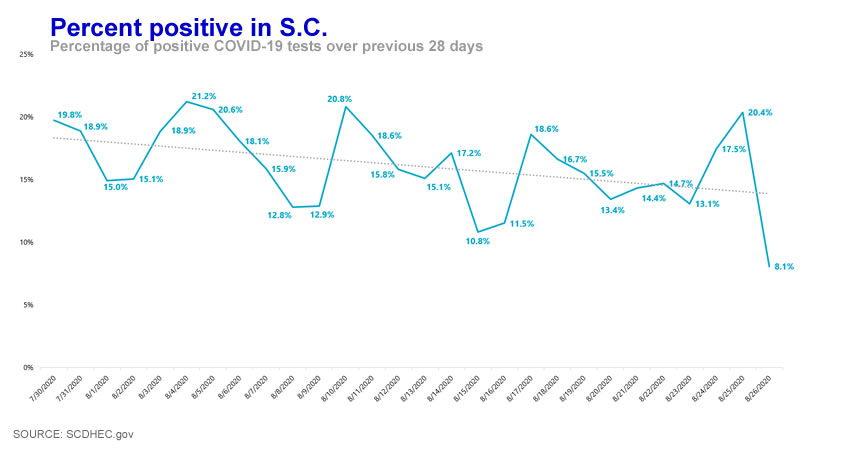 If you don’t do enough testing for the virus, then you don’t know how widespread it is in the community, experts say.
If you don’t do enough testing for the virus, then you don’t know how widespread it is in the community, experts say.
“If you report only the number of cases but you do not report the number of tests then you don’t know if the declining number of cases is a good thing,” said former USC professor and public health expert Gere Fulton of Columbia. “What we really need to know from a public health standpoint is whether or not things are getting safer for people in South Carolina.”
To understand whether the state is doing enough testing, experts point to two indicators: the percentage of positive tests and hospital-bed occupancy.
“If the percent positive is not going up with the decrease in testing then that would mean that the decrease in cases is not due to the decrease in testing,” Rennert said. “But if the percent positive is staying positive or going down then it’s a sign that cases are not going down due to the decreased testing.”
A percent positive of 5 percent is recommended by federal and international organizations, such as the World Health Organization, for virus control and considerations for reopening the economy. It’s a metric that has peaked and valleyed in South Carolina, usually hovering between 10 and 20 percent.
“We continue to look at several metrics. We would like for the percent positive to be lower than it is currently,” Traxler said.
But if cases are truly dropping, Rennert said, the state should also see fewer hospitalizations. According to DHEC data, hospital-bed occupancies for all regions appear to be on the rise over the last week.
- Have a comment? Send to: feedback@statehousereport.com
Goldfinch urges flooding fixes now
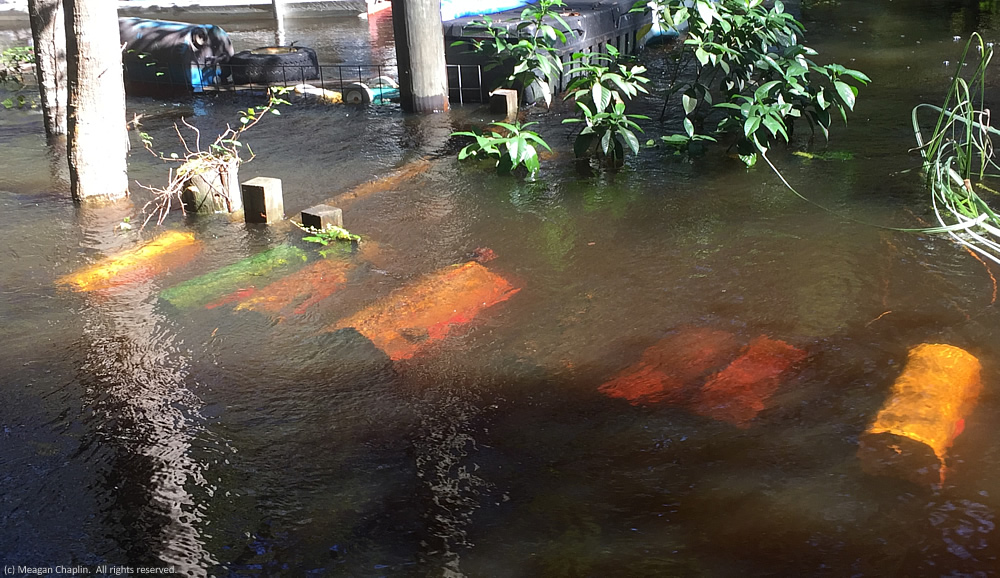
By Lindsay Street, Statehouse correspondent | Coronavirus and the state’s budget may be the top priorities in the lead-up to a September mini-legislative session, but flooding also isn’t going away and lawmakers have a chance to do something about it, Murrells Inlet Republican Sen. Stephen Goldfinch told Statehouse Report Wednesday.
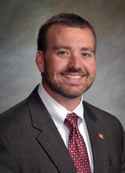
“Everybody is lobbying for their own little pet project to happen in September. Flooding should absolutely be at the top of the list. It is a huge economic problem in South Carolina,” he said.
South Carolina watched from a thousand miles away this week as a Category 4 hurricane came ashore in the Gulf of Mexico. Hurricane Laura was expected to have an “unsurvivable” 20-foot storm surge in Cameron Parish, Louisiana — although after the storm swept through, some say that surge swelled to a more modest, but still devastating 9 feet and brought waters 40 miles inland.
Storm surge from a Category 4 storm would swamp as far inland as St. Stephen, Conway, Moncks Corner, Walterboro and across Interstate 95 in Jasper County — all about 40 miles inland, according to a NOAA interactive map.
Goldfinch is the lead sponsor of Senate Bill 259, which seeks to create a revolving fund and a governing body to help low-lying property owners get low-interest buyout loans from the bank.
The bill passed the Senate 44-1 on March 19 and was referred to the House Ways and Means committee. Committee Chair Murrell Smith, R-Sumter, did not respond to a request to comment on the bill and whether it could get a vote on the House floor when the body meets Sept. 15.
In a similar vein, in 2019, the U.S. Department of Housing and Urban Development began offering $16 billion for “large-scale migration or relocation” and other steps to deal with flooding. North Carolina, South Carolina and Texas have since expressed interest in using that money to fund buyouts, the purchasing and demolishing of homes exposed to storms, among other things, according to The New York Times.
In other news:
![]() Budget stuff remains unclear, but still some surplus. The revenue forecasters for state spending met Aug. 24 to close the books on the fiscal year of 2019-2020, which ended June 30, but had revenues delayed as tax deadlines were extended amid the pandemic. The year ended with about $467 million above the $9.4 billion originally predicted for revenues, according to Revenue and Fiscal Affairs Executive Director Frank Rainwater. (For context, in January, Rainwater’s team was predicting a $507 million surplus, on top of unexpectedly recurring surplus revenues from the previous year of $350 million.) However in an interview Thursday, the state’s Comptroller General Richard Eckstrom said the year closed at a $775 million budget surplus. That includes money that agencies didn’t spend and that’s why it doesn’t match with the figures reported Monday, Rainwater said.
Budget stuff remains unclear, but still some surplus. The revenue forecasters for state spending met Aug. 24 to close the books on the fiscal year of 2019-2020, which ended June 30, but had revenues delayed as tax deadlines were extended amid the pandemic. The year ended with about $467 million above the $9.4 billion originally predicted for revenues, according to Revenue and Fiscal Affairs Executive Director Frank Rainwater. (For context, in January, Rainwater’s team was predicting a $507 million surplus, on top of unexpectedly recurring surplus revenues from the previous year of $350 million.) However in an interview Thursday, the state’s Comptroller General Richard Eckstrom said the year closed at a $775 million budget surplus. That includes money that agencies didn’t spend and that’s why it doesn’t match with the figures reported Monday, Rainwater said.
Now comes the tricky part for the Board of Economic Advisors: Predicting what revenues the state should expect for the 2020-2021 fiscal year. It will convene again 1 p.m. Aug. 31 to discuss predictions. Many expect advisors to be conservative in their estimates.
- Related: Senate budget writers convene Sept. 1. The Senate Finance Committee will meet 10 a.m. Sept. 1 virtually for more than six hours of scheduled testimony from state leaders on the economy and revenue. See the agenda here.
Home births facilitated by midwives could change. The S.C. Department of Health and Environmental Control is proposing changes for midwives — licensed medical professionals who facilitate births outside a hospital setting — that could make having a home birth more difficult for some but allow midwives to perform at-home suturing and intravenous fluid procedures. Any changes will need to be approved by the state legislature. Read more.
House equity committee talks forfeiture reform Aug. 31. The Civil Asset Forfeiture Reform subcommittee of the House’s Equitable Justice System and Law Enforcement Reform Committee meets 2:30 p.m. Aug. 31 in room 110 of the Blatt building on Statehouse grounds in Columbia. The meeting will hear testimony from four witnesses on the law enforcement practice of seizing a person’s assets before a trial. See the agenda and witness list here.
Senate convenes Sept. 2. The Senate will convene as a full body noon Sept. 2 in its chamber at the Statehouse in Columbia. Senate President Harvey Peeler said the body would discuss making voting safe for the Nov. 3 general election.
House committee to look at federal funds starting Sept. 2. The House Ways and Means CARES Act Ad Hoc committee will meet virtually 2 p.m. Sept. 2 and Sept. 9 on updates on initial federal funding authorization and on what’s needed for a second phase of funding. The committee met this week for more than an hour in a meeting conducted by Executive Budget Office Director Brian Gaines. See the agenda here.
House convenes Sept. 15. The House of Representatives will convene as a full body noon Sept. 15 in its chamber at the Statehouse in Columbia.
- Have a comment? Send to: feedback@statehousereport.com
Sanford is on target about debt, deficit

By Andy Brack, editor and publisher | Mark Sanford is onto something: If the United States doesn’t get control of the exploding national debt and deficit, the country will fade away.
 As of Friday, the national debt was $26.6 trillion dollars. That’s 266 followed by 11 zeros.
As of Friday, the national debt was $26.6 trillion dollars. That’s 266 followed by 11 zeros.
This number is mind-numbing. Every second, the national debt goes up by $270,000. The total debt equates to more than $80,000 per person in a country where the federal government collects 10 times less per citizen per year, according to the USDebtClock.org.
The national deficit — what we’re adding to the debt every year — has exploded to $2.9 trillion per year.
This amount of borrowing to spend trillions more than the nation collected in taxes is a familiar theme for Sanford, the state’s former penny-pinching Republican governor and congressman. He has been railing against profligate spending since he rocketed onto the political scene in the U.S. House’s Gingrich revolution of 1994.
“Our present financial course is unsustainable,” Sanford said in a statement announcing his new nonprofit, Americans for Debt and Deficit Reduction. “Never have we seen this level of debt in peacetime and it will have grave consequences for each one of us if left unchecked.
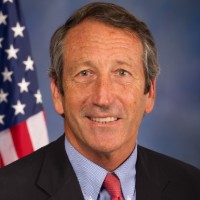
“History shows that soaring national debt, deficits and government spending are hardly a recipe for national prosperity, and more people need to be informed on this.”
The statement noted “America’s debt levels, when measured against the size of our economy, will soon amass levels not seen since World War II and the Great Depression. The current coronavirus pandemic amplifies these trends, and this makes it that much more important that people have a firm understanding of the impact of governmental debt, deficits and spending.”
Sanford is right. He may not be the perfect messenger, as evidenced by how social media criticized a media appearance in which his background looked like a wrinkled white sheet. Or his infamous Appalachian Trail excuse when he was really having an affair.
But he’s right. We’ve got to get this thing under control. It’s eating away at the country’s power and competitiveness. It is, as some say, a clear and present danger to our future security. If Democrats and Republicans don’t stop spending so much, there won’t be much left for much more than paying interest on what we’ve been borrowing. Profligate spending will drown the government to the point that services will dwindle and our infrastructure will rot. Our children and grandchildren’s America will be hardly recognizable compared to what adults have had in recent years.
Sanford isn’t the only South Carolinian who has raised Cain about the soaring deficit and debt. The late U.S. Sen. Fritz Hollings chaired the Senate Budget Committee in the early 1980s when the national debt went over $1 trillion for the first time. By 1993 when I worked for him, the national debt had grown to $4.4 trillion. It made Hollings apoplectic. Two years later when Sanford was in his first term, the debt was $5 trillion. It’s more than quadrupled since then.
Sanford’s slog to get people to wake up to the perils of too much borrowing and fiscal irresponsibility is compelling because it has huge political potential to do something that Washington can’t seem to do — unite. Curbing deficit spending and reining in the debt are issues that can bring politicians together, regardless of party. It’s what America needs now. Yes, we can solve some of our social issues. But we won’t have the capacity for more fixes if we don’t get our fiscal house in order.
“To his credit, Sanford has been willing to raise the national debt as a serious problem, while both Republicans and Democrats have kicked the can down the road,’ said Greenville political strategist Chip Felkel, who has long ties to the Republican Party. “This group can have an impact, gain support from both sides of the aisle, certainly outside of D.C. and in D.C., too, if the solutions they offer are executable and aren’t perceived as draconian.
“While that might be the approach needed, it won’t pick up steam if you try to fix this all at once. Sanford’s on to something. Let’s hope people listen.”
Indeed.
- Andy Brack is editor and publisher of Statehouse Report. His column also is published in the Charleston City Paper, Florence Morning News, Greenwood Index Journal, The (Seneca) Journal, Camden Chronicle Independent and Hartsville Messenger. Have a comment? Send to: feedback@statehousereport.com.
The S.C. Education Association
 The public spiritedness of our underwriters allows us to bring Statehouse Report to you at no cost. This week’s spotlighted underwriter is The South Carolina Education Association(The SCEA), the professional association for educators in South Carolina. Educators from pre-K to 12th grade comprise The SCEA. The SCEA is the leading advocate for educational change in South Carolina. Educators in South Carolina look to The SCEA for assistance in every aspect of their professional life. From career planning as a student to retirement assessment as a career teacher, The SCEA offers assistance, guidance, and inspiration for educators.
The public spiritedness of our underwriters allows us to bring Statehouse Report to you at no cost. This week’s spotlighted underwriter is The South Carolina Education Association(The SCEA), the professional association for educators in South Carolina. Educators from pre-K to 12th grade comprise The SCEA. The SCEA is the leading advocate for educational change in South Carolina. Educators in South Carolina look to The SCEA for assistance in every aspect of their professional life. From career planning as a student to retirement assessment as a career teacher, The SCEA offers assistance, guidance, and inspiration for educators.
- Learn more: TheSCEA.org
Get serious about pandemic responses
To the editor:
![]() Go get ‘em, Gov. McMaster. Almost seven months into this crisis and we still lack a game plan to win. Here is one for the common good team.
Go get ‘em, Gov. McMaster. Almost seven months into this crisis and we still lack a game plan to win. Here is one for the common good team.
Gov. Henry McMaster agreed to accept federal unemployment aid from the Trump administration. Great! Finally, a valid S.C. recovery program putting our skin in the game that matches the real world in our state.
Next, order statewide masking — without exception in all indoor places: Offices, schools and bars (if they are open.) Masking is a proven strategy to get us all to where we need to go better, faster and cheaper.
Third, ramp up to the superior level with the state’s testing program. Dead lives matter. Jobs matter. Children matter. We all matter.
Next, offer two years of tuitionless occupational education across the S.C. educational institutions to transition the economy. Expand the Lifeboat Jobs initiative of the S.C. Department of Employment and Workforce. Too many jobs are not coming back soon.
Harness the resources to address evictions, hunger and dislocation heading to S.C.
Change your mindset. Understand COVID-19 is not a flood waiting for the water to recede. A pandemic requires an anticipatory strategic look ahead. Use the offense to run up the prevention scoring.
— Fred Palm, Edisto Island, S.C.
Brack doesn’t know what he’s talking about
To the editor:
Here you go again. Putting your opinionated spin on something you obviously don’t know anything about.
Until just a few years ago, you could have mail [sent in Pamplico] by 6 a.m. and the local recipient would get it that day. Then some “smart” powers that be (years before Trump) decided that all local mail must be picked up and sent to Columbia to be post marked and returned to locals to deliver. It takes no less than a week/weeks if delivered at all.
We do a barbecue every Christmas and have for 20 years. We mail 200 invitations a month in advance. The mail has gotten so bad with folks never receiving invitations that I have sent messages.
My husband and I live in the house he was born in on a rural route. For the last five years I get mail for a family 5 miles from me and our route names are nowhere near the same. Only the number. We both have put it back in the mail with a correction on the envelope. Repeated complaints to the post office makes absolutely no difference.My sister-in-law lives in Charleston. She mailed a Christmas card post marked Dec 17. It arrived in the middle of February.
Now explain to me how I am being conned on postal service? There is no way on God’s green earth mail in voting is not a Democrat [sic] hoax. By the way our “blue box “ has been gone way before all of the Trump conspiracy. You know there is a difference in absentee voting and what is planned. All I ask of you is be fair. Don’t let blind hate overrule common sense.
— Lois Griffin, Pamplico, S.C.
Send us your thoughts
We love hearing from our readers and encourage you to share your opinions. But to be published, you’ve got to provide us with contact information so we can verify your letters. Letters to the editor are published weekly. We reserve the right to edit for length and clarity. Comments are limited to 250 words or less. Please include your name and contact information.
-
- Send your letters or comments to: feedback@statehousereport.com
Mystery painting

Here’s a photo sent in by a reader that shows part of a painting that’s somewhere in the state. What is it and where is it? Send to feedback@statehousereport.com. And don’t forget to include your name and the town in which you live.
Our previous Mystery Photo
 Our Aug. 21 photo, “Unusual building,” pulled in responses from all over the state and as far away as California. It showed the dome house, a hurricane-proof building, on the northern end of Sullivan’s Island.
Our Aug. 21 photo, “Unusual building,” pulled in responses from all over the state and as far away as California. It showed the dome house, a hurricane-proof building, on the northern end of Sullivan’s Island.
Congratulations to those who identified it: George Graf of Palmyra, Va.; Mary Greene and Jay Altman, both of Columbia; Frank Bouknight of Summerville; Carl Blum of Johns Island; Daniel Brownstein, David Lupo and Larry Murray, all of Mount Pleasant; Robert Ariail of Camden; Joe Mendelsohn of Charleston; Paula Egelson of Atlanta, Ga.; Daniel Prohaska of Moncks Corner, Will Williams of Aiken; Greg Leventis of Oakland, Calif.; Barry Wingard of Florence; Henry Eldridge of Tega Cay; and Allan Peel of San Antonio, Texas.
Lupo said the house is known as “Eye of the Storm” for being “constructed after Hurricane Hugo destroyed the previous house on the lot in 1989. The owners’ son happened to be in the business of constructing concrete buildings, and he along with a local architect came up with the oval dome design, which they hoped would survive the next storm to come along.”
Send us a mystery: If you have a photo that you believe will stump readers, send it along (but make sure to tell us what it is because it may stump us too!) Send to: feedback@statehousereport.com and mark it as a photo submission. Thanks.
Ever wonder where the Atlantic Ocean started?
Here is a preview of four more factual snippets from the new book, 350 Facts About Charleston:
Start of the Atlantic Ocean
 According to old-time wags and natives who see Charleston as the epicenter of the world, the Atlantic Ocean actually starts in Charleston harbor at the confluence of the Ashley and Cooper rivers. (See Robert Ariail’s cartoon at right that’s the cover of the book.) The late U.S. Sen. Fritz Hollings, born in the Holy City in 1922, often was heard saying, “Every great city has a great river. London has the Thames. New York has the Hudson. Washington has the Potomac. And Charleston, Andrew, Charleston has two great rivers — the Ashley and the Cooper — and that’s where the Atlantic Ocean starts.”
According to old-time wags and natives who see Charleston as the epicenter of the world, the Atlantic Ocean actually starts in Charleston harbor at the confluence of the Ashley and Cooper rivers. (See Robert Ariail’s cartoon at right that’s the cover of the book.) The late U.S. Sen. Fritz Hollings, born in the Holy City in 1922, often was heard saying, “Every great city has a great river. London has the Thames. New York has the Hudson. Washington has the Potomac. And Charleston, Andrew, Charleston has two great rivers — the Ashley and the Cooper — and that’s where the Atlantic Ocean starts.”
The state was occupied by natives for millennia before colonization
At least 29 distinct tribes of Native Americans lived in the borders of modern-day South Carolina before the arrival of European settlers. The names of many tribes are still with us today in places like the Stono and Ashepoo rivers, Kiawah Island and Edisto Island. The native population sharply declined after the arrival of the Europeans, who brought diseases such as smallpox and conflicts over trade practices and land. Many tribes are now extinct; a few tribes, though, still exist and are active today, including the Catawba, Pee Dee and Santee tribes. Many tribes made their homes around what would become Charleston, such as the Edisto, Kiawah, Stono and Etiwan tribes.
Getting here in olden days was a nightmare for travelers
The ships that made the voyage to the Carolinas in 1669 were met with rough waters and even rougher weather. Damaged in the first trip to Barbados, ships were scattered by storms during the next outing, during which one shipwrecked and another disappeared in a hurricane. It wasn’t until the following year that the expedition’s surviving ship, the Carolina, dropped anchor at the mouth of the Ashley River, with the only known date of arrival to be “early in April,” 1670.
Carolina was a “colony of a colony”
Charleston and Barbados have a strong connection. In 1670, the Lords Proprietors invited Englishmen who had spent up to four decades successfully settling on the Caribbean island to be part of the expedition to start the Carolina colony. Settlers in the Carolinas imported the “Barbados Model” of governance, which included forced labor by indentured servants and enslaved Africans. “Carolina thus became what one historian called a ‘colony of a colony’ — a colony of Barbados,” according to Rhoda Green, honorary consul for Barbados in South Carolina. Other similarities between the two are found in similar surnames, such as Drayton, Middleton and Gibbes, and similar architecture, such as how the Charleston single house may be adapted from a type of dwelling in Barbados.
350 Facts About Charleston, a new book of historical facts commemorating the 350th anniversary of the city of Charleston, will be available in print in mid-September. Published by the staff of sister publication, Charleston City Paper, you can pre-order a copy today.
ABOUT STATEHOUSE REPORT
Statehouse Report, founded in 2001 as a weekly legislative forecast that informs readers about what is going to happen in South Carolina politics and policy, is provided to you at no charge every Friday.
Meet our team
- Editor and publisher: Andy Brack, 843.670.3996
- Statehouse correspondent: Lindsay Street
We’re proud to offer Statehouse Report for free. For more than a dozen years, we’ve been the go-to place for insightful independent policy and political news and views in the Palmetto State. And we love it as much as you do.
But now, we can use your help. If you’ve been thinking of contributing to Statehouse Report over the years, now would be a great time to contribute as we deal with the crisis. In advance, thank you.
Buy the book
Now you can get a copy of editor and publisher Andy Brack’s We Can Do Better, South Carolina! ($14.99) as a paperback or as a Kindle book ($7.99). . The book of essays offers incisive commentaries by editor and publisher Andy Brack on the American South, the common good, vexing problems for the Palmetto State and interesting South Carolina leaders.
More
- Mailing address: Send inquiries by mail to: 1316 Rutledge Ave., Charleston, SC 29403
- Subscriptions are free: Click to subscribe.
- We hope you’ll keep receiving the great news and information from Statehouse Report, but if you need to unsubscribe, go to the bottom of the weekly email issue and follow the instructions.
- Read our sister publications: Charleston City Paper (every Wednesday) | Charleston Currents (every Monday).
- © 2020, Statehouse Report, a publication of City Paper Publishing, LLC. All rights reserved.


